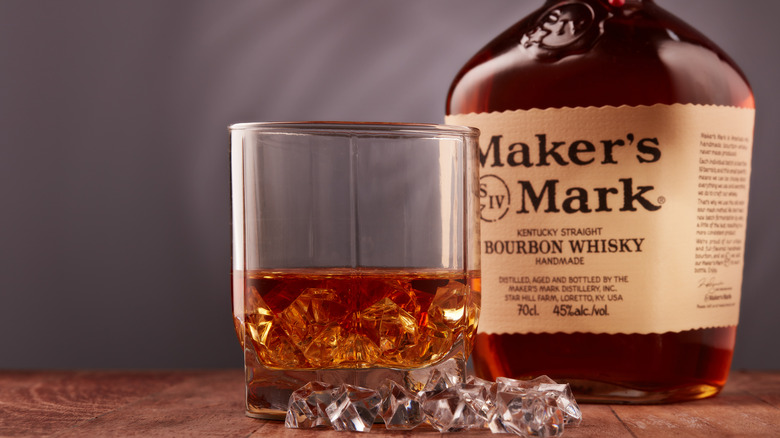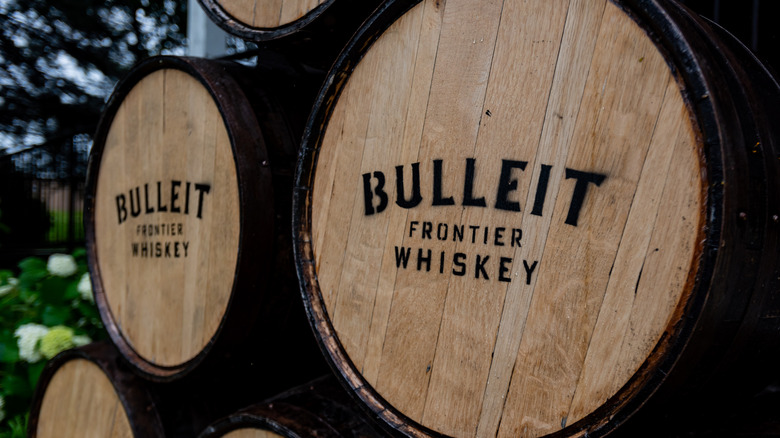The Difference Between High-Wheat And High-Rye Bourbon
Bourbon whiskey, by law, must be corn-based (minimum 51%). It's also possible to make bourbons with 100% corn. In most cases, however, other grains are used in the bourbon-making process, such as barley, wheat, and rye. The recipe that determines the relative amounts of these ingredients is called the mash bill.
Additional grains may be added to mash bills for different purposes. Malted barley, for instance, is predominantly used to aid fermentation. Wheat and rye, by contrast, are added for flavor. Thus, bourbons described as high-wheat or high-rye are typically those which have been made with a higher concentration (usually about 20%) of one of these grains, with the intention of creating a specific flavor profile.
This isn't the only way flavor is created in bourbon. Barrel aging — all bourbon must be aged for two years or more in charred new oak barrels – accounts for half of the flavor, if not more (the lengthier the aging process, the more flavors imparted). But high-wheat and high-rye bourbons are quite distinctive in this regard. In fact, some of the most famous bourbon brands are made using this type of mash bill. Bulleit Bourbon, for example, a notable high-rye bourbon, specifies 28% rye in its mash bill, to go along with its 68% corn and 4% barley.
What high-wheat bourbon means, and who makes the best
Anyone who drinks bourbon with regularity has almost certainly tried a high-wheat bourbon. That's because the wheated bourbon category contains some of the most popular and sought brands, including Maker's Mark, Pappy Van Winkle, Larceny, Rebel Yell, and W.L. Weller. The namesake of the latter bourbon from Buffalo Trace — William Larue Weller — is credited with inventing the first wheated bourbon circa 1849. Weller eschewed rye entirely in his historic wheated bourbon, a preference that holds true for most bourbons in the category today. Generally speaking, wheat imparts sweeter, more mellow flavors in bourbon, with vanilla and caramel among the most commonly cited flavor notes.
Maker's Mark Kentucky Straight Bourbon is perhaps the most famous wheated bourbon. Its mash bill features 70% corn and 16% red winter wheat, with the remainder made up of malted barley. Bill Samuels Sr., the legendary founder of Maker's Mark, is the man responsible for the mash bill, which he created in the 1950s, reputedly from a 170-year-old family recipe. Maker's Mark and Pappy Van Winkle, another famed wheated bourbon, both use less than 20% wheat. The latter uses 17% wheat in its mash bill, the same percentage favored by W.L. Weller.
Rebel Yell, meanwhile, as well as Heaven Hill, produced wheated bourbons under the Larceny and Old Fitzgerald brands, all have mash bills with 20% wheat.
The flavor profile of high-rye bourbons
High-rye bourbons should not be confused with rye whiskey. Rye whiskey, like bourbon, is an iconic and historic American spirit — one that, by law, requires at least 51% of its namesake grain. High-rye bourbons, meanwhile, contain less than that, since corn is the dominant grain in bourbon. That said, there tends to be more rye in high-rye bourbons than there is wheat in high-wheat varieties, and while wheated bourbons are known for their mellowness, rye is famed for its spicy complexity and peppery finish.
Woodford Reserve, the official bourbon of the Kentucky Derby for the last 24 years, is perhaps the most notable high-rye bourbon. But several other high-profile brands also specialize in the style, including Bulleit, Old Grand-Dad, Basil Hayden's, and Four Roses. The latter features 35% rye in its mash bill, while Bulleit contains 28%, and Basil Hayden's and Old-Grand-Dad have 27%. However, the highest of the high-rye producers, may be Redemption, which balances its 60% corn with 38.2% rye.


